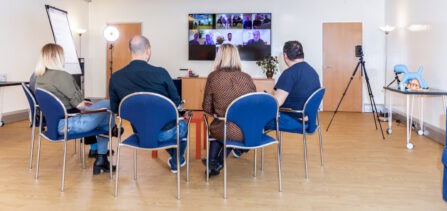
Making Work Work: Back to Normal?
We’ve had time and space to reassess our priorities. We enjoy the autonomy and sense of being in charge of our own lives!
Workplace Revolution – Or Back to Work?
The great debate about returning to the workplace has already been going on for while and most likely will carry on for some time to come.
Big companies who initially insisted all their people return to the office have had to back-pedal in the face of people not only saying no but quitting to find a job that better suits their needs.
Back to Normal or Something In-Between?
Here are just a few questions for you:
- What is your workplace going to look like over the next few months?
- What do you want it to look like?
- Is there conflict or agreement about the next steps?
It is fairly clear that some form of hybrid arrangement is going to prevail for some time, if not forever.
It isn’t a matter of ‘getting back to normal’ since normal has changed, in some cases, beyond all recognition.
It’s far more a matter of how are you going to engage with your whole workforce so that your business thrives.
Imposed Change and Empowerment
The pandemic created imposed change. Aside from key workers, most people were compelled to lock down and work from home.
In general, people don’t respond well to imposed change: they rebel, become disgruntled and discontent, and will often undermine the change that has been imposed.
For the most part that didn’t happen.Instead, people adapted in the most creative, ingenious, and surprising ways, and many – like a LOT – found they liked it.
There are a number of reasons worth mentioning.
Empowerment
The first and most important reason is that many people, in finding their individual ways of coping
- juggling work
- childcare and homeschooling
- grocery shopping and cooking
- being separated from loved ones and colleagues
- experiencing isolation and grief
They felt empowered!
In the face of being told what they could and couldn’t do, they took control of their lives in new ways.
It may have been stressful with sleep and eating patterns disrupted, but within their boundaried world, they got to make choices about how to make a good work-life balance.
They Liked It
The second reason is that for whole swathes of the population, working from home was simply easier.
Yes, technical problems abounded and the juggling could be exhausting, but this was counterbalanced by:
- no commuting
- every day being dress-down Friday
- finding a rhythm that worked
- ultimately, being more productive
- even saving money not buying lunches
- and all those enticements when you pop out for a bite to eat
Flexible Working Hours
The third reason is why many people became more productive: they felt less pressure without bosses micro-managing and looking over their shoulders.
They made their days work better by shaking things up, creating different routines, and including different dynamics throughout the day.
For instance, I break my day up by taking time to do a crossword puzzle, read a chapter of a book or sit in my rocker watching the birds at the bird feeder, pop down to my allotment; things I’d never do at the office (aside from the fact we don’t have a bird feeder at the office, nor an allotment).
My days work much better for me.
Reassessing Priorities
Without a doubt, there were loads of people who raced back to the office as soon as they were allowed and others are now champing at the bit to return. But not all, and probably not most.
People have had the time and space to reassess their priorities; they enjoy the autonomy and sense of being in charge of their own lives.
They don’t want to return to a way of working that may suit the higher-ups but not themselves.
People are questioning the patriarchal paradigm which has been the accepted way of doing things, for the most part, forever, it seems.
Over these 18 months people’s work personas have matured, they have felt more trusted (including trusting themselves to get things done their way) and they have seen that the ‘old ways’ are not necessarily the best ways.
This is the First in a Three-Part series of Blogs
The Second Blog will be looking at the situation from a neuroscience perspective:
How the brain works best and how we can help it thrive.
Written by our colleague, Sarah Creevy.
The third part will be looking at
Things Managers and Senior Leaders can do to manage things more effectively.
More About Hybrid Working
Read our In-Depth Articles
The Future of Training is Hybrid
The Pros and Cons of Hybrid Training
See More About Our – Hybrid Training Offer



